Science & Environment
Wildlife Photographer of the Year: Tadpoles win top prize
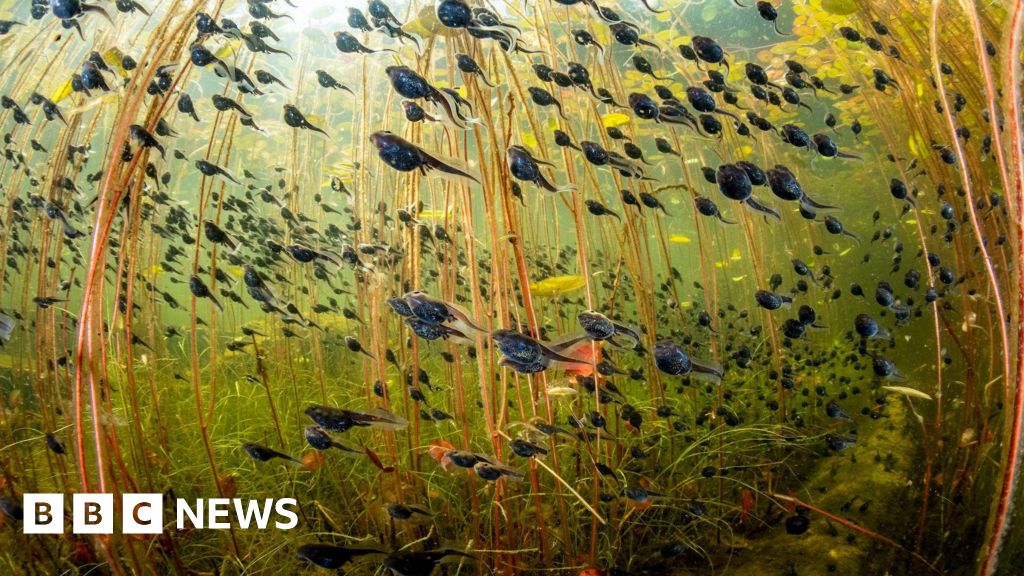
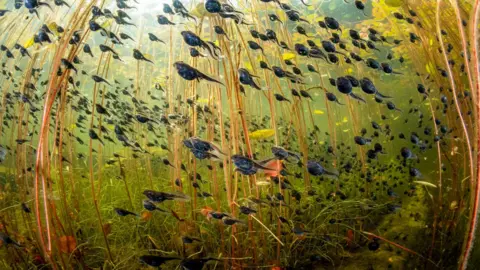 Shane Gross
Shane GrossA snapshot of wriggling toad tadpoles has earned Shane Gross the title of Wildlife Photographer of the Year.
Beneath a floating canopy of lily pads in Cedar Lake, Canada, a swarm of western toad tadpoles glided gracefully through the water.
“To me, the most fun that I can have, the thing that lights me up inside, is to see something new and try to photograph it in the best way I possibly can,” Shane told BBC News.
His careful movements through the delicate layer of silt and algae at the lake’s bottom ensured a clear view.
“I had no idea if I had anything good at all until I got home,” he said. “But when I finally looked, I was like, wow, this is pretty cool.”
Within four to twelve weeks after hatching, these little tadpoles begin their transformation into toads, with only about 1% making it to adulthood.
He was awarded the prize at London’s Natural History Museum.
“This image swirls with light, energy and a feeling of synchronised movement between the lilies and the tadpole tails,” said Kathy Moran, Jury Chair and Editor. “The real payoff is that this wonderful scene highlights environments and species that are often overlooked.”
Scroll on to see all of the winning photographs.
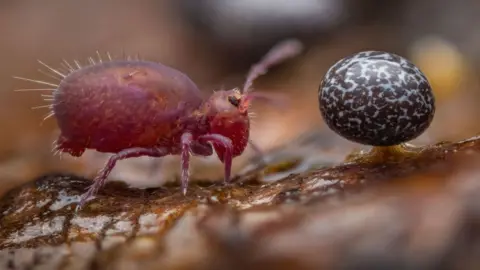 Alexis Tinker-Tsavalas
Alexis Tinker-TsavalasAlexis Tinker-Tsavalas, 17, from Germany, won the Young Wildlife Photographer of the Year title. His photo “Life Under Dead Wood” featured fruiting slime mould alongside a tiny, energetic springtail.
Working quickly was essential, as these tiny critters can leap several times their body length in the blink of an eye.
“I think a lot of people don’t know that these things even exist,” Alexis said. “If people learn more through my images, I feel like that’s one of the biggest goals for me, to just show this tiny world that a lot of people don’t really get to see, in a different light.”
Using a technique known as focus-stacking, he combined 36 images into one stunning photograph.
These miniature springtails, under two millimetres long, are found alongside slime moulds worldwide, munching on microorganisms and playing a key role in soil health.
Category winners
Dusting for New Evidence by Britta Jaschinski, Germany/UK
 Britta Jaschinski
Britta JaschinskiBritta Jaschinski observed as a crime scene investigator from London’s Metropolitan Police dusted a confiscated tusk at Heathrow Airport for fingerprints, using newly developed magnetic powder.
Under the Waterline by Matthew Smith, UK/Australia
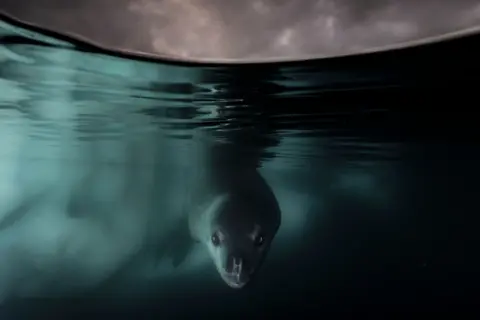 Matthew Smith
Matthew SmithMatthew Smith captured a striking split image of a curious leopard seal beneath the Antarctic ice, using a custom extension he designed for his camera’s underwater housing.
Dolphins of the Forest by Thomas Peschak, Germany/South Africa
 Thomas Peschak
Thomas PeschakThe Amazon River dolphin, one of two freshwater dolphin species in the Amazon and Orinoco basins, uniquely adapts to explore seasonally flooded forest habitats.
Thomas Peschak highlights the endangered dolphins’ complex relationship with local communities and the challenges they face due to human interactions that disrupt their natural behaviours.
Tiger in Town by Robin Darius Conz, Germany
 Robin Darius Conz
Robin Darius ConzWhile filming a wildlife documentary in India’s western ghats, Robin Darius Conz saw a tiger on a hillside overlooking a town. He used a drone to track the tiger, to highlight the contrast between protected areas and those affected by human development.
A Tranquil Moment by Hikkaduwa Liyanage Prasantha Vinod, Sri Lanka
 Hikkaduwa Liyanage Prasantha Vinod
Hikkaduwa Liyanage Prasantha VinodAfter photographing birds and leopards, Hikkaduwa Liyanage Prasantha Vinod captured a young toque macaque peacefully sleeping in an adult’s arms to highlight the challenges these monkeys face amid habitat loss and farmer conflicts.
The Demolition Squad by Ingo Arndt, Germany
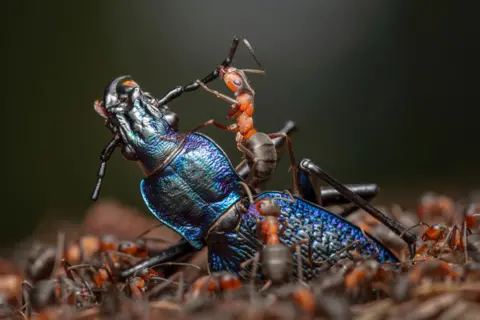 Ingo Arndt
Ingo ArndtIngo Arndt captured the red wood ants efficiently dismembering a blue ground beetle to carry into their nest. He described himself as “full of ant” after just a few minutes lying beside the ants’ nest as he watched their teamwork in action.
Free as a Bird by Alberto Román Gómez, Spain
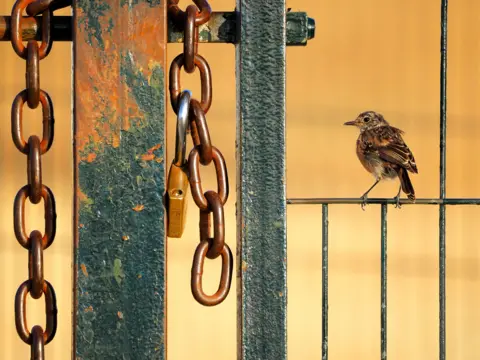 Alberto Román Gómez
Alberto Román GómezAlberto Román Gómez captured a playful stonechat perched beside a heavy chain, resembling a tiny warrior. From his father’s car in Sierra de Grazalema Natural Park, he struggled to photograph the bird as it darted about, gathering insects.
Frontier of the Lynx by Igor Metelskiy, Russia
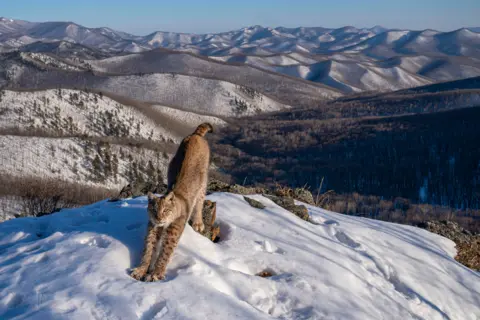 Igor Metelskiy
Igor MetelskiyMr Metelskiy captured a serene image of a lynx stretching in the evening sun, blending into the wilderness. After over six months of patience, he positioned his camera trap near the footprints of potential prey, revealing the elusive lynx in its natural habitat.
Old Man of the Glen by Fortunato Gatto, Italy
 Fortunato Gatto
Fortunato GattoFortunato Gatto came across a gnarled birch tree draped with pale ‘old man’s beard’ lichens in Glen Affric in the Scottish highlands. Glen Affric is home to the highest concentration of native trees in the UK, making it a vital ecosystem.
Practice Makes Perfect by Jack Zhi, USA
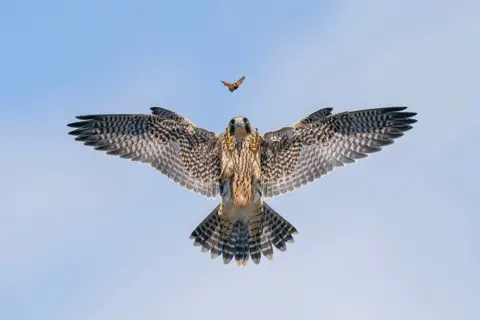 Jack Zhi
Jack Zhi Jack Zhi captures a young falcon practicing hunting on a butterfly near its sea-cliff nest. For the past eight years, he observed the birds in this area, but tracking them was particularly challenging as they were so fast.
The Artful Crow by Jiří Hřebíček, Czech Republic
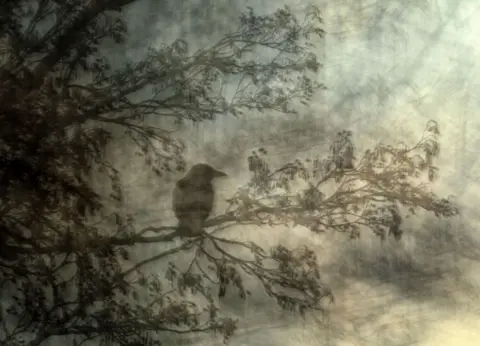 Jiří Hřebíček
Jiří HřebíčekJiří Hřebíček created an artistic image of a carrion crow by using a long shutter speed while moving his camera on purpose.
On Watch by John E Marriott, Canada
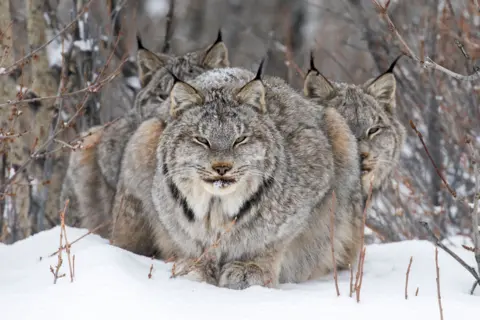 John E Marriott
John E MarriottJohn Marriott photographs a lynx resting, with its fully grown young sheltering from the cold wind behind it. After a week of tracking led him to the group, he kept his distance to avoid disturbing the family in the snowy forest.
A Diet of Deadly Plastic by Justin Gilligan, Australia
 Justin Gilligan
Justin GilliganJustin Gilligan created a mosaic from 403 pieces of plastic found in the digestive tract of a dead flesh-footed shearwater. He has been documenting research from a team that studies the impact of plastic pollution on marine ecosystems.
An Evening Meal by Parham Pourahmad, USA
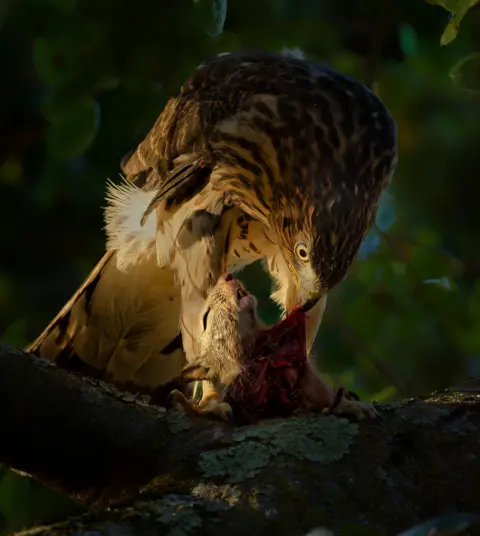 Parham Pourahmad
Parham PourahmadParham Pourahmad watched the last rays of sunlight highlight a young Cooper’s hawk eating a squirrel. Over the summer, he photographed wildlife in a city park to show that “nature will always be wild and unpredictable”.
Wetland Wrestle by Karine Aigner, USA
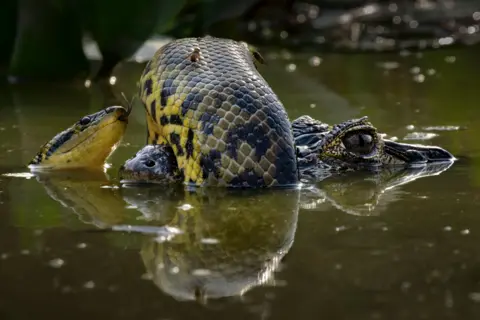 Karine Aigner
Karine AignerKarine Aigner spotted a yellow anaconda coiled around the snout of a yacaré caiman while leading a tour group. She observed the two reptiles struggling, uncertain which was the aggressor, while horseflies clung to the snake’s back.
The Serengeti of the Sea by Sage Ono, USA
 Sage Ono
Sage OnoTube-snout fish eggs glimmer among golden kelp, their colours fading as they develop. Sage Ono, inspired by his grandfather’s marine biology stories, captures the unique underwater life of Monterey Bay’s giant kelp forests.
“I like small and weird. So, when I saw the eggs and the kelp, I was like, okay, this is something I don’t have a photograph of. I’ve never really seen a photograph of it, so it’s really interesting to me.” Sage said.
Science & Environment
Stocks’ choppiness in October can be an opportunity

A view from the Alaska Bootanical Park, fall, Halloween and harvest season themed version of the Alaska Botanical Park with special displays, inside the Far North Bicentennial Park, Alaska, United States on September 22, 2024.
Hasan Akbas | Anadolu | Getty Images
This report is from today’s CNBC Daily Open, our international markets newsletter. CNBC Daily Open brings investors up to speed on everything they need to know, no matter where they are. Like what you see? You can subscribe here.
What you need to know today
Rebound rally
U.S. stocks rebounded on Tuesday, with all major indexes rising. Technology stocks, in particular, rallied to lift the Nasdaq Composite. The pan-European Stoxx 600 index lost 0.55%. European liquor producers like LVMH, Pernod Ricard and Diageo slumped after China announced anti-dumping measures on brandy products imported from the European Union.
Cooling oil prices
Crude oil prices fell on Tuesday amid reports Israel might focus on striking Iran’s military sites in retaliation for its missile attacks, according to reports by The New York Times and The Jerusalem Post. Both West Texas Intermediate and Brent futures retreated 4.63% yesterday, halting the red-hot rally oil prices have experienced the past week.
GM’s not slowing down
General Motors aims to bring in between $13 billion and $15 billion in adjusted earnings before interest and taxes for 2024. The Detroit automaker also expects its 2025 adjusted earnings to be in a “similar range,” said CFO Paul Jacobson during the company’s investor day. That’d be an accomplishment, given the slowdown in the industry.
Shorting Roblox
Short seller Hindenburg Research alleged on Tuesday that Roblox conflated daily active users with the number of people visiting its platform. This distorts the true number of people accessing Roblox because DAUs could include bots or alternate accounts, Hindenburg said. Roblox denies all claims in the report.
[PRO] Slower earnings growth
Third-quarter earnings season ramps up this week, with banking giant JPMorgan Chase slated to announce its financial results on Friday. Investors might want to temper expectations. For companies in the S&P 500, Wall Street projects a slower pace of earnings growth compared with its estimate in June, according to FactSet data.
The bottom line
October in the U.S. is the season for pumpkin spice, but the month also harbors the dangerous edge of Halloween.
And getting spooked and soothed alternately is indeed what markets are doing in October.
After falling 0.96% on Monday, the S&P 500 added 0.97% on Tuesday. (Though it should be noted that doesn’t necessarily mean the S&P erased its losses and is up 1 basis point from Monday to Tuesday. Percentages are hard.)
Likewise, the Nasdaq Composite slipped 1.18% Monday but climbed 1.45% yesterday, zapped higher by a rally in tech stocks like Nvidia, Palo Alto Networks and Meta. The Dow Jones Industrial Average didn’t have that dramatic a swing, losing 0.94% Monday but advancing 0.3% Tuesday.
October, then, is truly living up to its reputation as the most volatile month for stocks. But investors should keep in mind the uncomfortable swings in markets aren’t always a good signal for the underlying health of stocks.
“While our expectation is for October to remain choppy, we don’t view the overall market action to be bearish and encourage investors to maintain perspective on the longer-term trends,” Robert Sluymer, technical strategist at RBC Wealth Management, wrote to clients in a Tuesday note.
Investment bank Piper Sandler has the same opinion on October’s turbulence. “October is historically a ‘backing and filling’ month as investors react to Q3 earnings results,” Craig Johnson, chief market technician, wrote in a Tuesday note.
In fact, when stocks dip because of mild repricing or a correction, that’s a good opportunity for investors to swoop in, according to Johnson.
The see-saw motion of stocks in October isn’t all that bad, then, if investors can seize the right time to enter the market or solidify their positions further. It doesn’t have to be spooky season all the time.
– CNBC’s Hakyung Kim, Samantha Subin and Alex Harring contributed to this story.
Science & Environment
Florida gas stations are running out of fuel as people flee Hurricane Milton


Nearly 16% of gas stations in Florida had run out of fuel as of late morning Tuesday as people flee north to escape the path of Hurricane Milton, according to data from GasBuddy.
Many stations simply can’t keep up with gasoline demand as millions of Floridians collectively evacuate, said Patrick De Haan, head of petroleum analysis at GasBuddy. About 1,200 of the state’s 7,900 gas stations are currently without fuel, according to the data.
“The sheer bulk of this is simply people getting out of harm’s way,” De Haan told CNBC. Prices should not rise as a consequence of the storm because infrastructure and refineries are not expected to be impacted, he said.
Milton is forecast to make landfall on the west-central coast of Florida on Wednesday night and then move east-northeastward across the central part of the state through Thursday, according to the National Hurricane Center.
Milton is currently a Category 4 storm with maximum sustained winds of 150 miles per hour. The storm is forecast to remain “an extremely dangerous hurricane” through landfall in Florida, according to the forecasters.
Florida Gov. Ron DeSantis said Tuesday morning that the state was stockpiling fuel ahead of the storm. Gas stations are running out of fuel and lines are long but there is not a shortage in the state, DeSantis said.
Fuel continues to arrive in Florida by port and trucks have been dispatching supplies to stations in the anticipated impact area, the governor said. The Port of Tampa and other Gulf Coast ports are not receiving ships but the facilities have fuel on hand and dockside operations will continue, he said.
There are no oil refineries in Florida and only 2,000 barrels of oil per day are produced in the state, said Andy Lipow, president of Lipow Oil Associates. However, there are several terminals along the waterfront in Tampa that could be impacted by Milton, Lipow said.
“They are at risk from storm surge, flooding, and power outages,” Lipow said in a Tuesday note. “Significant damage to these facilities will impact on the ability to get gasoline and diesel back into the area for distribution.”
Gasoline delivery by tanker likely will not be possible in Tampa until Sunday at the earliest, Lipow said. Terminals with power, however, could begin distribution of fuel Saturday and Sunday depending on worker and truck driver availability as well as whether local gas stations are working, he said.
Science & Environment
American Water, largest U.S. water utility, hit by cyberattack

Picture Alliance | Picture Alliance | Getty Images
American Water, the largest water utility in the U.S., disclosed that it had been hit by a cyberattack.
The Camden, New Jersey-based company said in a security statement on its website that it had learned of “unauthorized activity in our computer networks and systems” last Thursday, which it determined “to be the result of a cybersecurity incident.”
The company said on Tuesday that it shut down its customer service portal, and as a result, its billing function “until further notice” and will not charge any late fees or other fees related to billing as long as the system is down.
Some recent hacks of major U.S. companies have brought key online systems to a halt and created chaos for consumers and businesses, such as the hack of UnitedHealth which led to nationwide difficulty among patients needs prescriptions filled and health-care professionals needing to be paid for services.
Hacks targeting U.S. water infrastructure, in particular, have been increasing, with some of the attacks linked to geopolitical rivals of the U.S., including Iran, Russia and China.
Taking out critical national infrastructure has become a top priority for foreign-linked cybercriminals. “All drinking water and wastewater systems are at risk — large and small, urban and rural,” an EPA spokesman recently told CNBC.
American Water provides drinking water and wastewater services to more than 14 million people with regulated operations in 14 states and on 18 military installations.
One recent Russian-linked hack in January of a water filtration plant in a small Texas town, Muleshoe was located near a U.S. Air Force base. “Water is among the least mature in terms of security,” Adam Isles, head of cybersecurity practice for Chertoff Group, recently told CNBC.
The FBI warned Congress in February that Chinese hackers had penetrated deeply into United States’ cyber infrastructure in an attempt to cause damage, targeting water treatment plans, the electrical grid, transportation systems and other critical infrastructure.
America Water said it remains early in the investigation and “currently believes” that no water or wastewater facilities or operations have been impacted and water remains safe to drink.
Law enforcement and third-party cybersecurity experts are now involved, the company said.
American Water did not immediately respond to a request for additional comment.
The rising cybercrime wave targeting key water infrastructure led the Environmental Protection Agency to issue an enforcement alert warning that 70% of water systems it inspected do not fully comply with requirements in the Safe Drinking Water Act. Without quantifying an exact number, the EPA said some have “alarming cybersecurity vulnerabilities” — default passwords that have not been updated, vulnerable single login setups and former employees who retained systems access.
American Water said it first learned of the unauthorized computer access on October 3, and was subsequently able to determine it was a cyberattack. It said turning off customer systems was intended to protect data, though it added that it is too soon to know whether any customer information is at risk.

Science & Environment
Prices fall as rally takes a pause
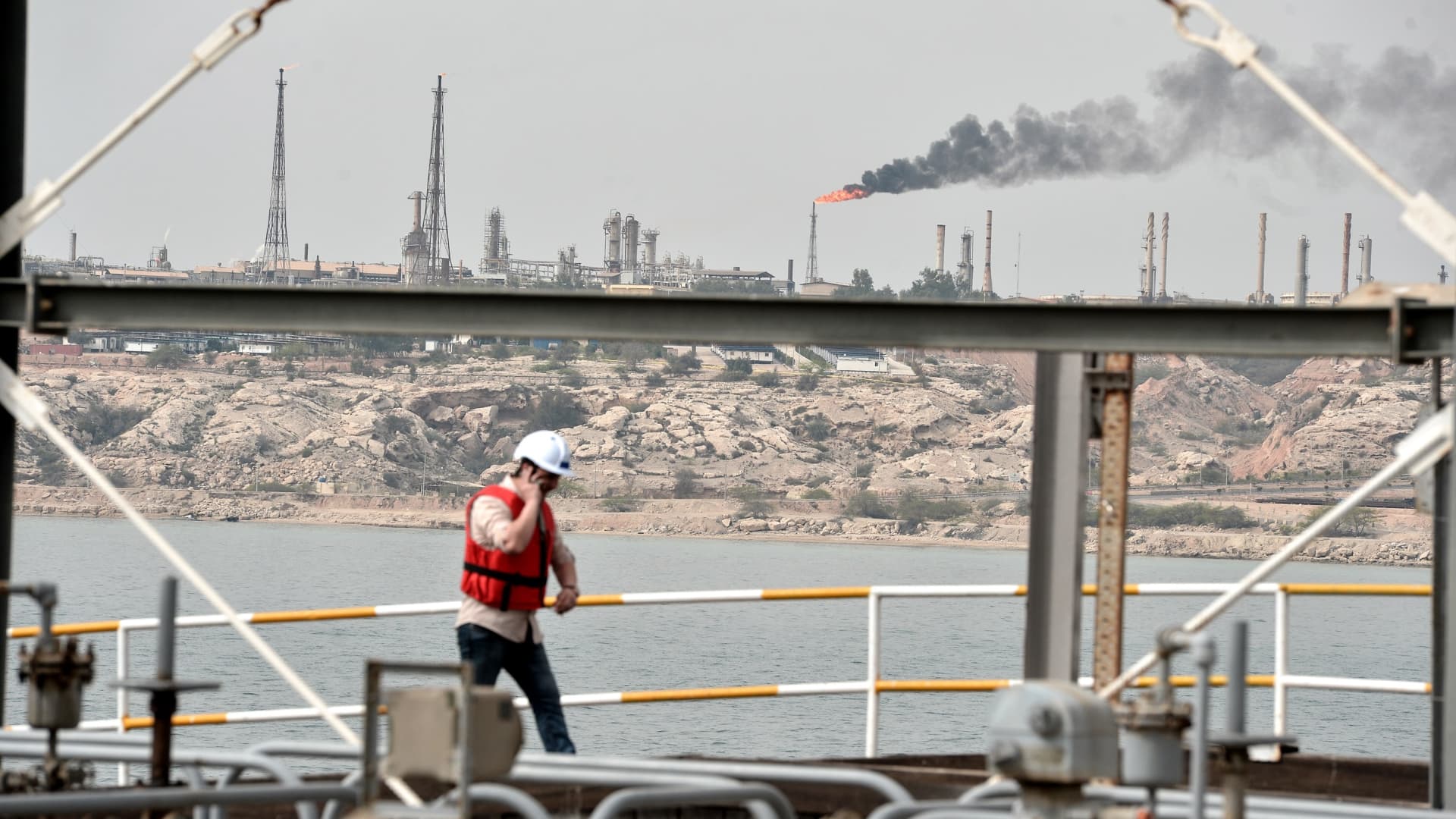

Crude oil futures fell about 2% on Tuesday, as the rally on geopolitical risk took a pause while the market waits for Israel to strike back against Iran.
“Oil can keep ascending only for so long purely based on perceptions and not actual supply disruption,” Tamas Varga, an analyst at oil broker PVM, said in a Tuesday note.
Oil prices have surged about 13% through Monday’s close since Iran fired 180 ballistic missiles at Israel last week, raising fears that Israel might retaliate by hitting Iran’s crude industry.
Here are Tuesday’s energy prices at around 7:39 a.m. ET:
- West Texas Intermediate November contract: $75.52 per barrel, down $1.62, or 2.1%. Year to date, U.S. crude has gained about 5%.
- Brent December contract: $79.31 per barrel, down $1.62, or 2%. Year to date, the global bench mark has risen more than 2%.
- RBOB Gasoline November contract: $2.1149 per gallon, down 1.81%. Year to date, gasoline has advanced more than 2%.
- Natural Gas November contract: $2.772 per thousand cubic feet, up 0.95%. Year to date, gas is ahead about 9%.
Science & Environment
Nobel Prize goes to scientists’ work on machine learning

The Nobel Prize in Physics has been awarded to two scientists, John Hopfield and Geoffrey Hinton, for their work on machine learning.
The announcement was made by the Royal Swedish Academy of Sciences at a press conference in Stockholm, Sweden.
Machine learning is key to artificial intelligence as it develops how a computer can train itself to generate information.
It drives a vast range of technology that we use today from how we search the internet to editing photographs on our phones.
The winners share a prize fund worth 11m Swedish kronor (£810,000)
This breaking news story is being updated and more details will be published shortly. Please refresh the page for the fullest version.
You can receive Breaking News on a smartphone or tablet via the BBC News App. You can also follow @BBCBreaking on Twitter to get the latest alerts.
Science & Environment
S&P Dan Yergin warns dangerous time for global economy on MidEast tensions
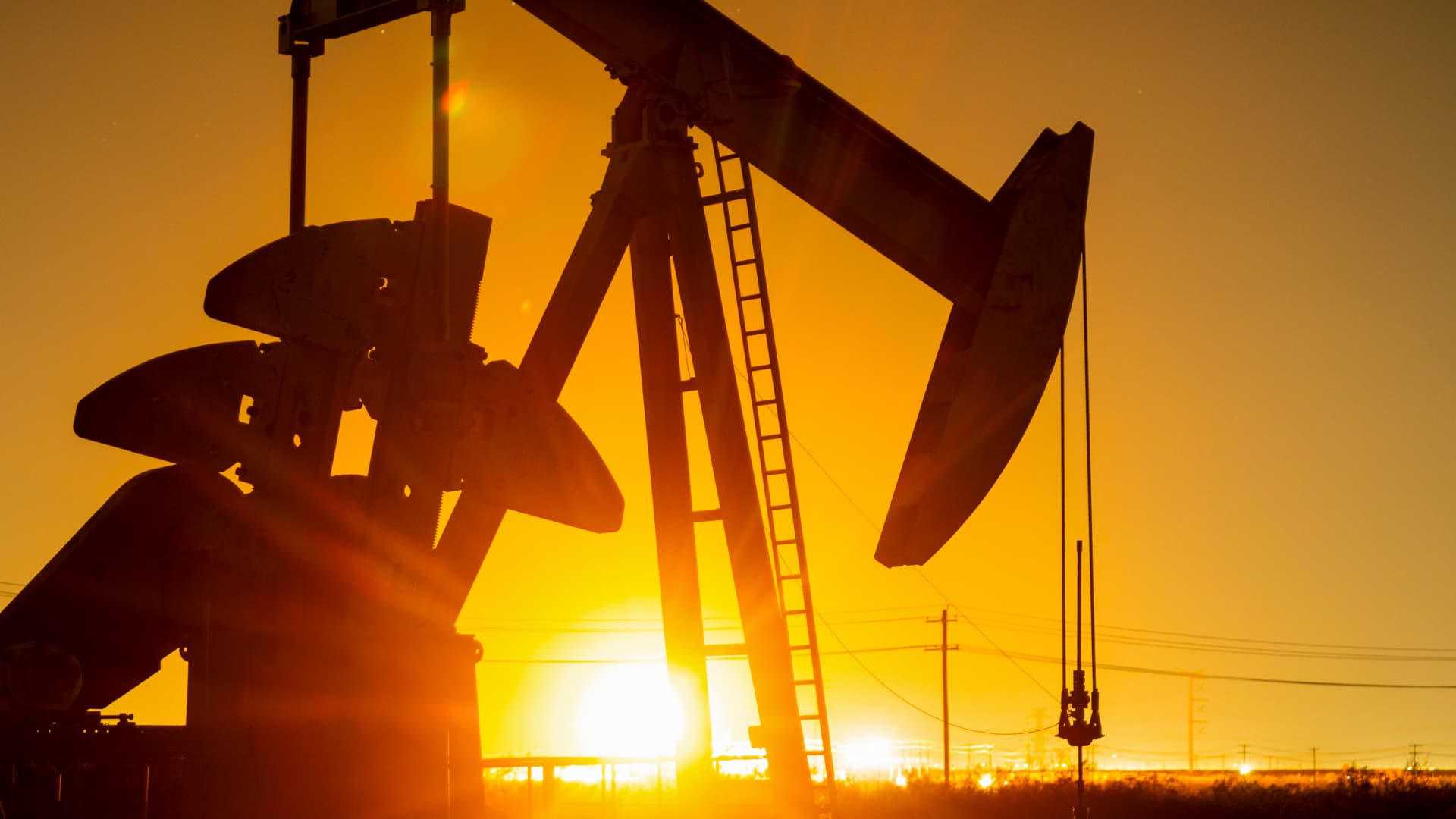

The global economy is entering a “dangerous time” like never before as Middle East tensions remain elevated, said S&P Global’s vice chairman Daniel Yergin.
Since the Israel-Hamas conflict began on Oct. 7 of last year, the oil market has experienced minimal disruptions, with prices remaining under pressure as a result of increased U.S. production and weak demand from China. However, this sentiment has been shifting. Oil prices spiked last week on fears that Israel could target Iran’s oil industry in retaliation for Tehran’s ballistic missile attack, with industry analysts raising concerns about a genuine threat to supply.
“The Israelis have not concluded what they’re going to do in terms of a strike — that’s under discussion,” U.S. President Joe Biden told reporters at a White House press briefing last week, adding that he discouraged Israel from striking Iranian oil facilities.
Last week, both oil benchmarks saw their biggest weekly gain since March 2023. During Asia trading on Tuesday, global benchmark Brent slipped 1.77% to $79.50 a barrel, while U.S. West Texas Intermediate traded 1.83% lower at $75.77 per barrel.
Yergin told CNBC’s “Squawk Box Asia” that he expects Israeli retaliation will not just be a replay of last April, but something “much stronger.”
In April, Iran and Israel came to blows but ultimately avoided a full-scale war. Iran fired hundreds of ballistic missiles and drones at Israel in retaliation for an attack on an Iranian diplomatic facility in Syria.
When asked if the global economy is on the precipice of another supply shock resulting from Middle East tensions, Yergin said it’s a precarious time for markets.
“I think it’s a very dangerous time, one that we haven’t seen,” he said.
Additionally, while Yergin maintained that it is not certain whether Iranians have operational nuclear weapons, that is still “certainly in the backdrop,” particularly through the lens of the Israelis.
“The betting is that the Israelis would not attack, try to attack, the nuclear facilities at this time. But a few months from now, a few weeks from now, whatever it is, Iran would have the capacity — it’s thought — to deliver a nuclear weapon, and that raises the stakes,” he said, likening the moment to the 1962 Cuban Missile Crisis.
That said, Israel is a lot more concerned about Iran’s nuclear facilities than the Iranian oil industry, said Pavel Molchanov, managing director of investment services firm Raymond James. Iran’s nuclear program has progressed to a stage where, in approximately one week, the country could potentially enrich enough uranium for five fission weapons, according to estimates by Iran Watch, a website published by the Wisconsin Project on Nuclear Arms Control.
“The worst-case scenario would be something that Iran can do on its own, which is a blockade of the Strait of Hormuz. So this is not directly related to Israeli airstrikes or missiles.
The strait, between Oman and Iran, is a vital channel where about one fifth of global oil production flows daily, according to the U.S. Energy Information Administration. It is a strategically important waterway linking crude producers in the Middle East with key markets across the world.
The inability of oil to traverse through the strait, even temporarily, can increase shipping costs, lead to considerable supply delays and ratchet up global energy prices, with some surmising that a worst-case scenario could prompt oil prices to surge above $100 a barrel.
-

 Womens Workouts2 weeks ago
Womens Workouts2 weeks ago3 Day Full Body Women’s Dumbbell Only Workout
-

 Science & Environment3 weeks ago
Science & Environment3 weeks agoHow to unsnarl a tangle of threads, according to physics
-

 Science & Environment3 weeks ago
Science & Environment3 weeks agoHyperelastic gel is one of the stretchiest materials known to science
-

 Technology3 weeks ago
Technology3 weeks agoWould-be reality TV contestants ‘not looking real’
-

 Science & Environment3 weeks ago
Science & Environment3 weeks ago‘Running of the bulls’ festival crowds move like charged particles
-

 Science & Environment3 weeks ago
Science & Environment3 weeks agoMaxwell’s demon charges quantum batteries inside of a quantum computer
-

 News2 weeks ago
News2 weeks agoOur millionaire neighbour blocks us from using public footpath & screams at us in street.. it’s like living in a WARZONE – WordupNews
-

 Science & Environment3 weeks ago
Science & Environment3 weeks agoSunlight-trapping device can generate temperatures over 1000°C
-
News3 weeks ago
the pick of new debut fiction
-

 Science & Environment3 weeks ago
Science & Environment3 weeks agoHow to wrap your mind around the real multiverse
-

 Science & Environment3 weeks ago
Science & Environment3 weeks agoQuantum ‘supersolid’ matter stirred using magnets
-

 Science & Environment3 weeks ago
Science & Environment3 weeks agoLiquid crystals could improve quantum communication devices
-

 Science & Environment3 weeks ago
Science & Environment3 weeks agoITER: Is the world’s biggest fusion experiment dead after new delay to 2035?
-

 Science & Environment3 weeks ago
Science & Environment3 weeks agoQuantum forces used to automatically assemble tiny device
-

 Science & Environment3 weeks ago
Science & Environment3 weeks agoPhysicists are grappling with their own reproducibility crisis
-

 Science & Environment3 weeks ago
Science & Environment3 weeks agoWhy this is a golden age for life to thrive across the universe
-

 News3 weeks ago
News3 weeks agoYou’re a Hypocrite, And So Am I
-

 Sport3 weeks ago
Sport3 weeks agoJoshua vs Dubois: Chris Eubank Jr says ‘AJ’ could beat Tyson Fury and any other heavyweight in the world
-

 Science & Environment3 weeks ago
Science & Environment3 weeks agoCaroline Ellison aims to duck prison sentence for role in FTX collapse
-
Business2 weeks ago
Eurosceptic Andrej Babiš eyes return to power in Czech Republic
-

 Science & Environment3 weeks ago
Science & Environment3 weeks agoTime travel sci-fi novel is a rip-roaringly good thought experiment
-

 Science & Environment3 weeks ago
Science & Environment3 weeks agoLaser helps turn an electron into a coil of mass and charge
-

 Science & Environment3 weeks ago
Science & Environment3 weeks agoNuclear fusion experiment overcomes two key operating hurdles
-

 Science & Environment3 weeks ago
Science & Environment3 weeks agoNerve fibres in the brain could generate quantum entanglement
-

 Technology2 weeks ago
Technology2 weeks ago‘From a toaster to a server’: UK startup promises 5x ‘speed up without changing a line of code’ as it plans to take on Nvidia, AMD in the generative AI battlefield
-

 Football2 weeks ago
Football2 weeks agoFootball Focus: Martin Keown on Liverpool’s Alisson Becker
-

 Science & Environment3 weeks ago
Science & Environment3 weeks agoRethinking space and time could let us do away with dark matter
-

 News3 weeks ago
News3 weeks ago▶️ Hamas in the West Bank: Rising Support and Deadly Attacks You Might Not Know About
-

 Science & Environment2 weeks ago
Science & Environment2 weeks agoX-rays reveal half-billion-year-old insect ancestor
-

 MMA2 weeks ago
MMA2 weeks agoConor McGregor challenges ‘woeful’ Belal Muhammad, tells Ilia Topuria it’s ‘on sight’
-

 News3 weeks ago
News3 weeks ago▶️ Media Bias: How They Spin Attack on Hezbollah and Ignore the Reality
-
Business2 weeks ago
Should London’s tax exiles head for Spain, Italy . . . or Wales?
-

 Science & Environment3 weeks ago
Science & Environment3 weeks agoA slight curve helps rocks make the biggest splash
-

 News3 weeks ago
News3 weeks agoNew investigation ordered into ‘doorstep murder’ of Alistair Wilson
-

 News3 weeks ago
News3 weeks agoIsrael strikes Lebanese targets as Hizbollah chief warns of ‘red lines’ crossed
-

 Science & Environment3 weeks ago
Science & Environment3 weeks agoFuture of fusion: How the UK’s JET reactor paved the way for ITER
-

 Science & Environment3 weeks ago
Science & Environment3 weeks agoA new kind of experiment at the Large Hadron Collider could unravel quantum reality
-

 Science & Environment3 weeks ago
Science & Environment3 weeks agoUK spurns European invitation to join ITER nuclear fusion project
-

 CryptoCurrency3 weeks ago
CryptoCurrency3 weeks agoCardano founder to meet Argentina president Javier Milei
-

 News2 weeks ago
News2 weeks agoWhy Is Everyone Excited About These Smart Insoles?
-

 Science & Environment2 weeks ago
Science & Environment2 weeks agoMeet the world's first female male model | 7.30
-

 Technology2 weeks ago
Technology2 weeks agoGet ready for Meta Connect
-

 Health & fitness2 weeks ago
Health & fitness2 weeks agoThe 7 lifestyle habits you can stop now for a slimmer face by next week
-

 Health & fitness3 weeks ago
Health & fitness3 weeks agoThe maps that could hold the secret to curing cancer
-

 Science & Environment3 weeks ago
Science & Environment3 weeks agoWhy we need to invoke philosophy to judge bizarre concepts in science
-

 CryptoCurrency3 weeks ago
CryptoCurrency3 weeks agoLow users, sex predators kill Korean metaverses, 3AC sues Terra: Asia Express
-
Politics3 weeks ago
UK consumer confidence falls sharply amid fears of ‘painful’ budget | Economics
-

 Womens Workouts3 weeks ago
Womens Workouts3 weeks agoBest Exercises if You Want to Build a Great Physique
-

 Womens Workouts3 weeks ago
Womens Workouts3 weeks agoEverything a Beginner Needs to Know About Squatting
-

 News2 weeks ago
News2 weeks agoFour dead & 18 injured in horror mass shooting with victims ‘caught in crossfire’ as cops hunt multiple gunmen
-

 Technology2 weeks ago
Technology2 weeks agoRobo-tuna reveals how foldable fins help the speedy fish manoeuvre
-

 Technology2 weeks ago
Technology2 weeks agoQuantum computers may work better when they ignore causality
-

 Sport1 week ago
Sport1 week agoWatch UFC star deliver ‘one of the most brutal knockouts ever’ that left opponent laid spark out on the canvas
-

 Sport3 weeks ago
Sport3 weeks agoUFC Edmonton fight card revealed, including Brandon Moreno vs. Amir Albazi headliner
-

 CryptoCurrency3 weeks ago
CryptoCurrency3 weeks agoEthereum is a 'contrarian bet' into 2025, says Bitwise exec
-

 Health & fitness3 weeks ago
Health & fitness3 weeks agoThe secret to a six pack – and how to keep your washboard abs in 2022
-
Business3 weeks ago
JPMorgan in talks to take over Apple credit card from Goldman Sachs
-

 Science & Environment3 weeks ago
Science & Environment3 weeks agoQuantum time travel: The experiment to ‘send a particle into the past’
-

 Science & Environment3 weeks ago
Science & Environment3 weeks agoBeing in two places at once could make a quantum battery charge faster
-

 Science & Environment3 weeks ago
Science & Environment3 weeks agoA tale of two mysteries: ghostly neutrinos and the proton decay puzzle
-

 CryptoCurrency3 weeks ago
CryptoCurrency3 weeks agoBitcoin miners steamrolled after electricity thefts, exchange ‘closure’ scam: Asia Express
-

 CryptoCurrency3 weeks ago
CryptoCurrency3 weeks agoDorsey’s ‘marketplace of algorithms’ could fix social media… so why hasn’t it?
-

 CryptoCurrency3 weeks ago
CryptoCurrency3 weeks agoDZ Bank partners with Boerse Stuttgart for crypto trading
-

 CryptoCurrency3 weeks ago
CryptoCurrency3 weeks agoBitcoin bulls target $64K BTC price hurdle as US stocks eye new record
-

 CryptoCurrency3 weeks ago
CryptoCurrency3 weeks agoBlockdaemon mulls 2026 IPO: Report
-
News3 weeks ago
The Project Censored Newsletter – May 2024
-

 TV2 weeks ago
TV2 weeks agoCNN TÜRK – 🔴 Canlı Yayın ᴴᴰ – Canlı TV izle
-

 Science & Environment2 weeks ago
Science & Environment2 weeks agoCNN TÜRK – 🔴 Canlı Yayın ᴴᴰ – Canlı TV izle
-

 Womens Workouts2 weeks ago
Womens Workouts2 weeks ago3 Day Full Body Toning Workout for Women
-

 Servers computers2 weeks ago
Servers computers2 weeks agoWhat are the benefits of Blade servers compared to rack servers?
-

 News2 weeks ago
News2 weeks agoUS Newspapers Diluting Democratic Discourse with Political Bias
-

 Technology2 weeks ago
Technology2 weeks agoThe best robot vacuum cleaners of 2024
-

 News3 weeks ago
News3 weeks agoChurch same-sex split affecting bishop appointments
-

 Politics3 weeks ago
Politics3 weeks agoTrump says he will meet with Indian Prime Minister Narendra Modi next week
-

 Science & Environment3 weeks ago
Science & Environment3 weeks agoHow one theory ties together everything we know about the universe
-

 News3 weeks ago
News3 weeks agoBrian Tyree Henry on voicing young Megatron, his love for villain roles
-

 Technology3 weeks ago
Technology3 weeks agoThe ‘superfood’ taking over fields in northern India
-

 Science & Environment3 weeks ago
Science & Environment3 weeks agoTiny magnet could help measure gravity on the quantum scale
-

 Science & Environment3 weeks ago
Science & Environment3 weeks agoHow do you recycle a nuclear fusion reactor? We’re about to find out
-

 CryptoCurrency3 weeks ago
CryptoCurrency3 weeks agoDecentraland X account hacked, phishing scam targets MANA airdrop
-

 CryptoCurrency3 weeks ago
CryptoCurrency3 weeks agoRedStone integrates first oracle price feeds on TON blockchain
-

 CryptoCurrency3 weeks ago
CryptoCurrency3 weeks ago‘No matter how bad it gets, there’s a lot going on with NFTs’: 24 Hours of Art, NFT Creator
-
Business3 weeks ago
Thames Water seeks extension on debt terms to avoid renationalisation
-
Business3 weeks ago
How Labour donor’s largesse tarnished government’s squeaky clean image
-
Politics3 weeks ago
‘Appalling’ rows over Sue Gray must stop, senior ministers say | Sue Gray
-

 News3 weeks ago
News3 weeks agoBrian Tyree Henry on voicing young Megatron, his love for villain roles
-

 CryptoCurrency3 weeks ago
CryptoCurrency3 weeks agoCoinbase’s cbBTC surges to third-largest wrapped BTC token in just one week
-

 MMA3 weeks ago
MMA3 weeks agoRankings Show: Is Umar Nurmagomedov a lock to become UFC champion?
-

 Travel2 weeks ago
Travel2 weeks agoDelta signs codeshare agreement with SAS
-

 Politics2 weeks ago
Politics2 weeks agoHope, finally? Keir Starmer’s first conference in power – podcast | News
-
Business1 week ago
Ukraine faces its darkest hour
-

 Technology3 weeks ago
Technology3 weeks agoiPhone 15 Pro Max Camera Review: Depth and Reach
-

 CryptoCurrency3 weeks ago
CryptoCurrency3 weeks agoCrypto scammers orchestrate massive hack on X but barely made $8K
-

 CryptoCurrency3 weeks ago
CryptoCurrency3 weeks agoSEC asks court for four months to produce documents for Coinbase
-

 CryptoCurrency3 weeks ago
CryptoCurrency3 weeks ago‘Silly’ to shade Ethereum, the ‘Microsoft of blockchains’ — Bitwise exec
-

 Womens Workouts3 weeks ago
Womens Workouts3 weeks agoHow Heat Affects Your Body During Exercise
-

 Womens Workouts3 weeks ago
Womens Workouts3 weeks agoKeep Your Goals on Track This Season
-

 Science & Environment3 weeks ago
Science & Environment3 weeks agoSingle atoms captured morphing into quantum waves in startling image
-

 News3 weeks ago
News3 weeks agoHow FedEx CEO Raj Subramaniam Is Adapting to a Post-Pandemic Economy
-

 CryptoCurrency3 weeks ago
CryptoCurrency3 weeks agoTelegram bot Banana Gun’s users drained of over $1.9M


You must be logged in to post a comment Login